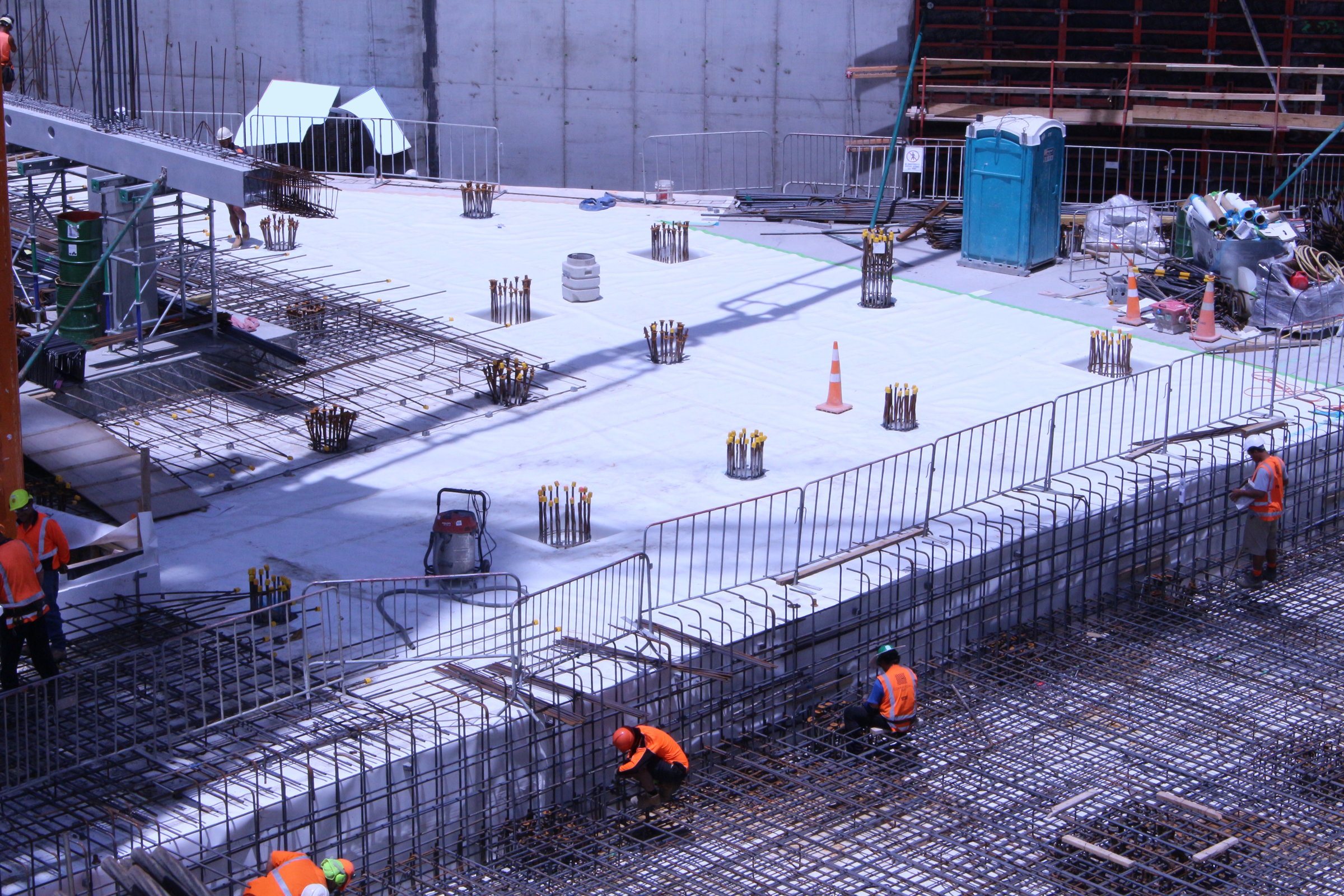Story at a glance:
- Placemaking is a collaborative, multi-faceted development approach that aims to create public spaces where people actually want to live, work, and play.
- Project for Public Spaces is one of the leading organizations advancing placemaking education.
- Winthrop Public Library, Shoppers World Brampton, and the Serenbe wellness neighborhood in Georgia are three varied examples of successful placemaking.
This idea of creating places people truly want to spend time rather than simply designing spaces for one function is known as placemaking.
In this article we provide an introductory glimpse into the world of placemaking, including what it is, why it’s important, and the principles that define it.
What is Placemaking?
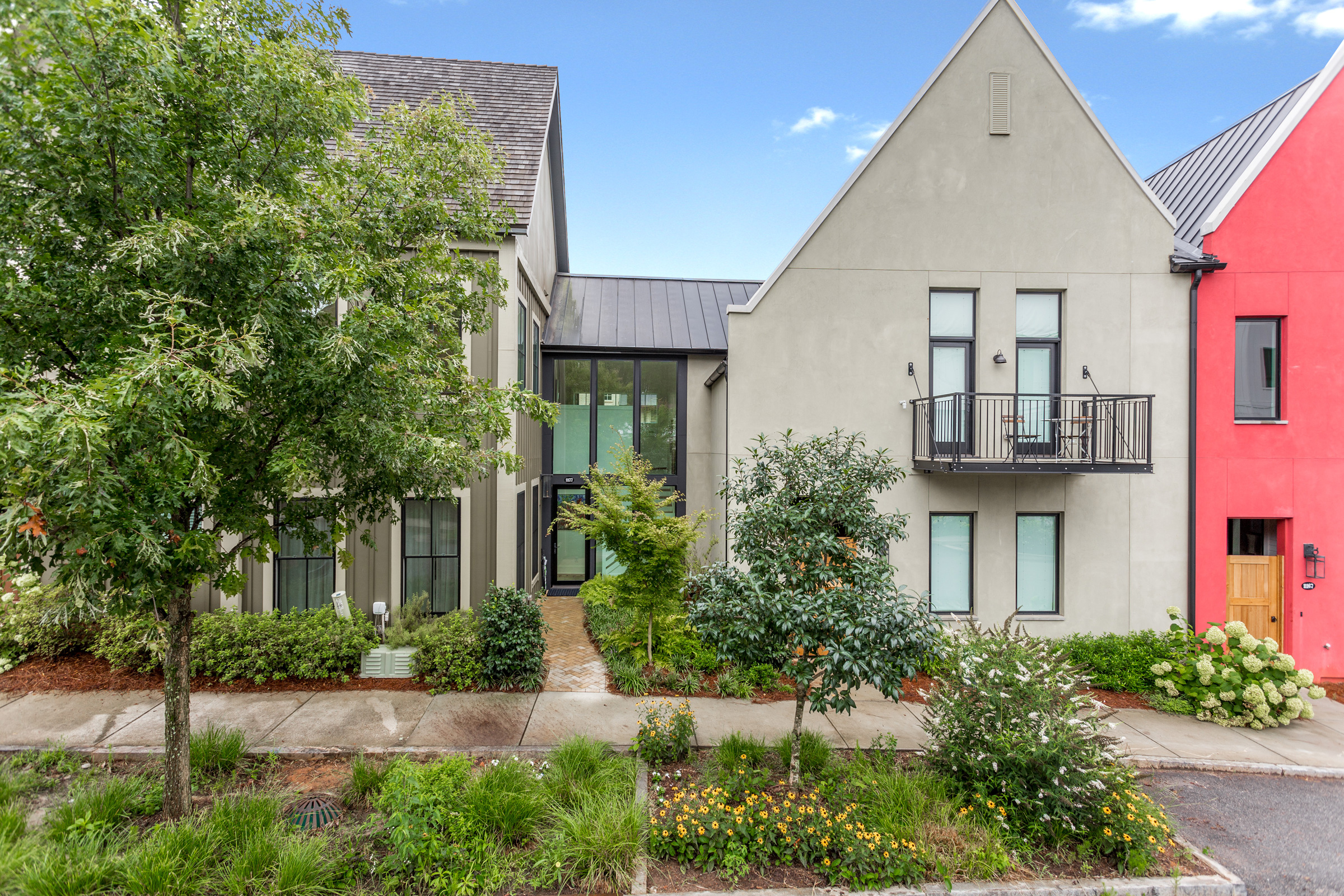
Placemaking aims to create spaces where people truly want to live, work, and play. Photo courtesy of Serenbe
Placemaking is best understood as a multi-faceted, community-oriented approach to the planning, development, and management of public spaces, one whose goal is ultimately to improve the overall urban vitality of a space and increase one’s desire to live, work, and play there.
Project for Public Spaces (PPS)—a cross-disciplinary nonprofit and one of the foremost organizations advancing placemaking education and strategies—expands on this, saying: “As both an overarching idea and a hands-on approach for improving a neighborhood, city, or region, placemaking inspires people to collectively reimagine and reinvent public spaces as the heart of every community. Strengthening the connection between people and the places they share, placemaking refers to a collaborative process by which we can shape our public realm in order to maximize shared value.”
When put into practice, the goal of placemaking is to enhance the urban experience at the pedestrian level and improve people’s happiness, health, and well-being.
Why is Placemaking Important?
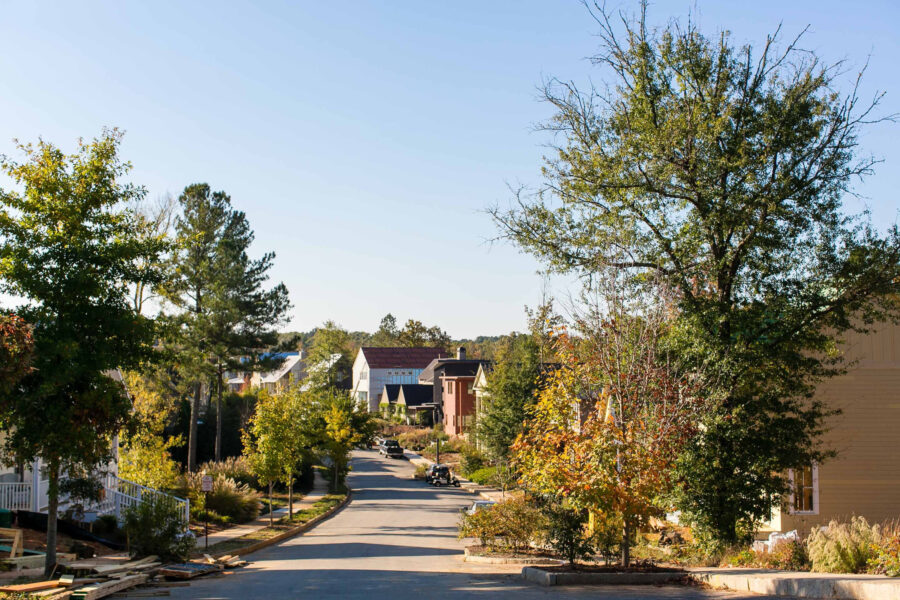
Serenbe’s development plan calls for hamlets based on English villages, designed with buildings clustered along serpentine-like forms that follow the land. This method of arranging the community requires minimal land disturbances and allows the community to reserve large areas of undeveloped green space. Specifically, 70% of the total land will be placed into conservation while the remaining 30% is developed in dense, walkable clusters. Photo courtesy of Serenbe
Placemaking as a practice provides a range of benefits depending on the type and scope of the project in question, with the most common being:
- Improves air quality. Placemaking often places an emphasis on improving pedestrian infrastructure, which in turn helps reduce dependency on and use of personal vehicles; this ultimately translates to fewer carbon emissions and cleaner outdoor air, leading to the improved health of those who use the space.
- Expands green space. While not true of all placemaking ventures, many improvements to public spaces involve adding or expanding access to existing green spaces; this helps conserve nature, promote biodiversity, provide opportunities for urban farming, and reduce the risk of urban flooding.
- Builds community. A hallmark of placemaking is community involvement and engagement, both during the planning stages and after project completion; placemaking also seeks to encourage and facilitate interpersonal interactions between residents/occupants, strengthening ties and building a stronger community.
- Bolsters local economies. Attractive public spaces are capable of bringing in new residents, businesses, customers, and tourists, which can in turn lead to increased retail sales, job creation, and investors; a well-designed public space, district, or community can also help raise real estate values, increasing local tax revenue.
Types of Placemaking
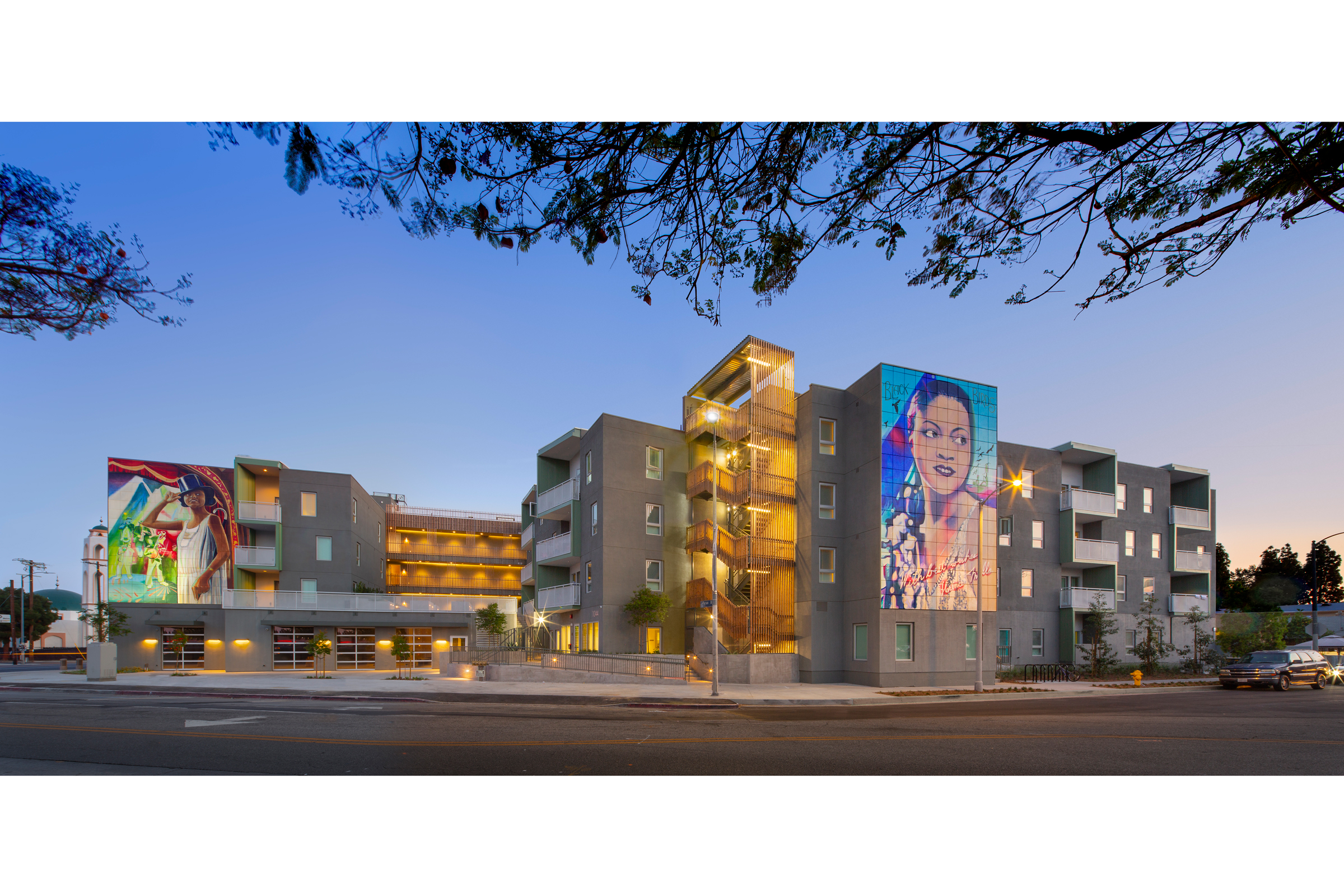
Murals—like the ones painted by Myisha Arellanus for the Florence Mills affordable housing complex—are potential example of creative placemaking. Photo by Jeff Simmons Photography
There are three widely recognized specialized types or subcategories of placemaking—strategic, creative, and tactical—that differ in part from the standard notion of placemaking in a few key ways.
Strategic
While standard placemaking describes the process of creating spaces where people want to live, work, and play, strategic placemaking looks to achieve a particular goal in addition to creating quality public spaces.
In most cases this goal is to attract talented workers as a means of stimulating job creation and economic growth—and specifically those knowledge workers whose skills allow them to live just about anywhere in the world, as they are more apt to consciously select quality places to live.
Strategic placemaking projects and activities have a tendency to operate on a longer timescale than most other placemaking ventures and are typically located along key transect corridors or nodes and in dense urban centers. When put into practice, strategic placemaking often takes the form of large, mixed-use projects that include ample opportunities for recreation, entertainment, and the arts.
Creative
Coined by Anne Gadwa and Ann Markusen in their 2010 white paper Creative Placemaking for the National Endowment for the Arts, creative placemaking differs from strategic placemaking in that, rather than focusing on attracting workers, it typically aims to institutionalize the arts, culture, and creative thinking in the built environment.
“In creative placemaking, partners from public, private, non-profit, and community sectors strategically shape the physical and social character of a neighborhood, town, city, or region around arts and cultural activities,” writes Gadwa and Markusen. “Creative placemaking animates public and private spaces, rejuvenates structures and streetscapes, improves local business viability and public safety, and brings diverse people together to celebrate, inspire, and be inspired.”
Tactical
Tactical placemaking recognizes that improvements to a space, neighborhood, or community almost always starts at the building, street, or block scale. Rather than try to develop a place all at once, tactical placemaking takes an incremental or phased approach and prioritizes small-scale improvements to public spaces based on realistic expectations.
The PPS champions their own form of tactical placemaking called “Lighter, Quicker, Cheaper” (LQC), a term borrowed from Eric Reynolds of Urban Space Management. LQC is characterized as a low-risk development strategy with a potentially high reward and often starts with improvements to amenities and public art, which then leads into intervention and event projects before transitioning into light development strategies that facilitate long-term change.
11 Principles of Placemaking
In their book How to Turn a Place Around, PPS outlines 11 principles that make up the foundation of placemaking as a practice:
1. The Community is the Expert
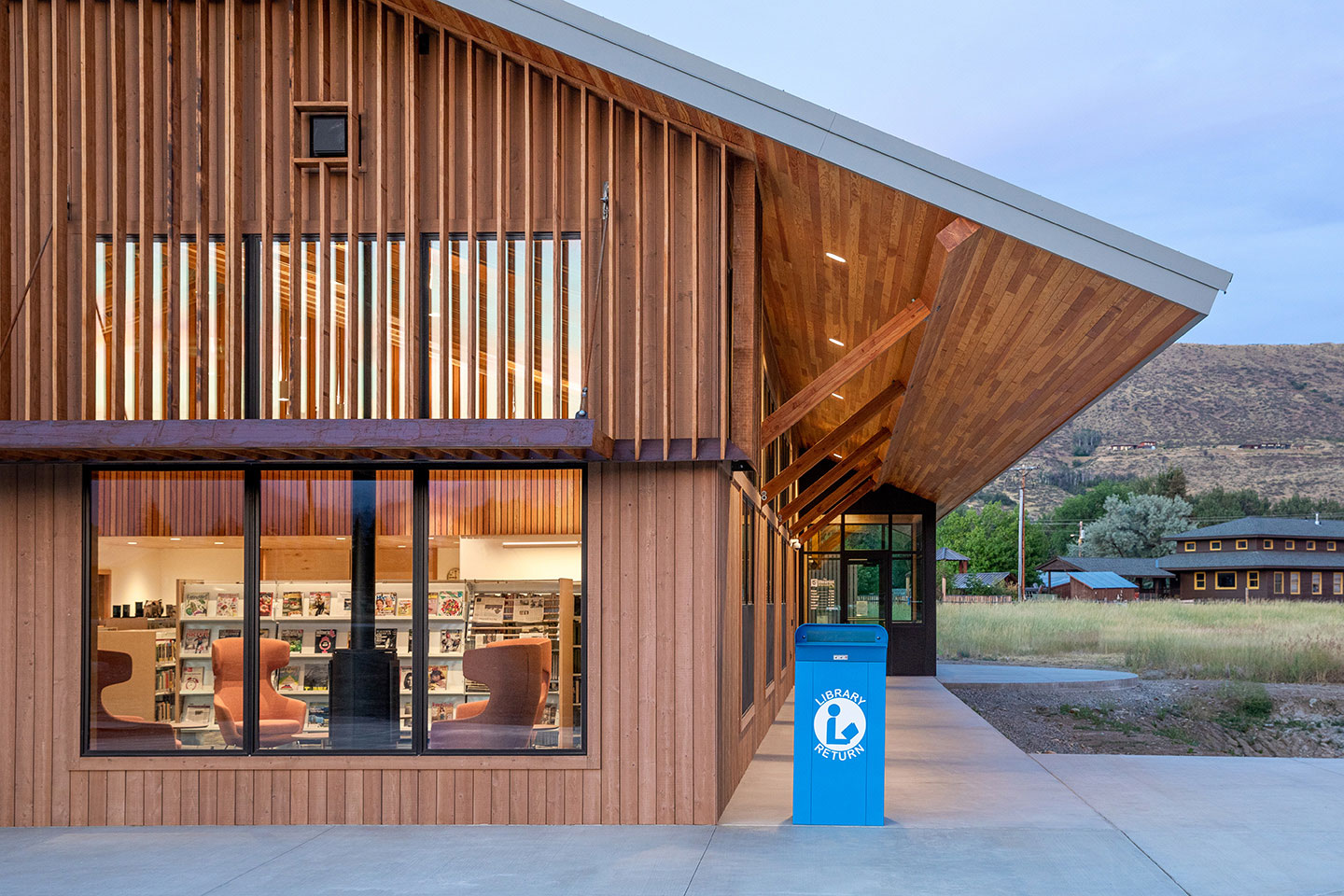
During the planning stage for the new Winthrop Public Library, Johnston Architects collected hundreds of suggestions from the community using their Hopes & Dreams charrette process. Photo by Benjamin Drummond
The placemaking philosophy recognizes that the talents and assets within the immediate community are valuable for conceptualizing and planning improved public spaces. Members of the community can provide unparalleled insight into what residents consider meaningful, how an area functions, the most pressing issues within a community, and may even be able to offer a historical perspective that can’t be found anywhere else.
Involving the community from the beginning can also help bolster accessibility and instill a sense of community ownership in the project, making it more likely to succeed over the long term.
2. Create Places, Not Designs
Contrary to what one might expect, placemaking is not focused on designing spaces but instead about creating places—and while that may sound like the same thing, there’s an important distinction. Physical design elements like comfortable seating, landscaping, and even artistic pieces can help define or characterize a place, but they alone are not capable of transforming an under-performing space into a “place.”
Placemaking goes beyond design and requires facilitating changes in pedestrian circulation patterns, the organizing of activities in the public space, and the development of more effective relationships between the surrounding commercial spaces and the public at large. It is these elements that help foster a strong sense of community.
3. It Can’t be Done Alone
If it weren’t already obvious, placemaking isn’t something that can be done by an individual, a developer, or a single firm—rather, it is a highly collaborative process that requires input from a diverse array of voices and people of varied experiences.
This principle ties heavily into the first and recognizes that the community and other partners are integral to getting a project off the ground and creating a successful public place.
4. Observation is Key
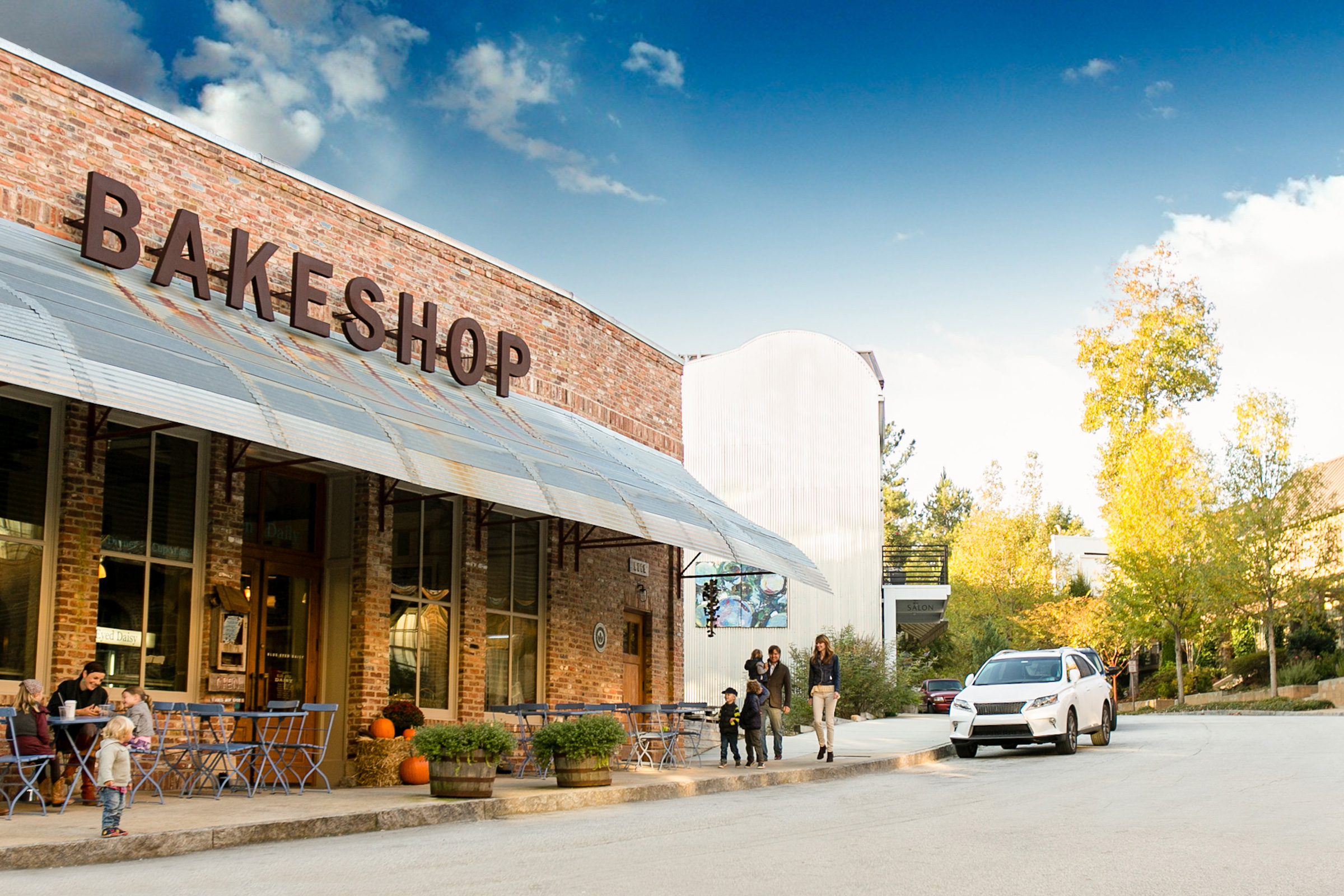
Observing existing public spaces can help shed light on what is and isn’t working. Photo courtesy of Serenbe
Observation of existing spaces is a crucial step in placemaking, one that offers insight into how people are using (or not using) public spaces and what makes them work or what might be required to make them better.
Of course, observation isn’t something that stops once the place in question is created; it’s a continuous act that carries over into the post-development stage and an important tool in figuring out how a space can continue to change, adapt, and improve over time.
5. Form Supports Function
Placemaking ventures may place an emphasis on aesthetics, but they are fundamentally about placing function over form—or at the very least, placemaking recognizes that the form should be influenced by and support the intended function.
This translates to the physical concept for the space itself being derived from input offered forth by partners and the community, experimentation with different solutions, and the overcoming of obstacles along the way.
6. Start With the Flowers
“Starting with the flowers” encapsulates the idea that, when put into practice, placemaking is incredibly complex and impossible to get right on the first try. Rather than become overwhelmed by this prospect, PPS urges architects and planners to start small with short-term improvements (e.g. flowers, benches, murals, et cetera) that can be built and expanded upon as the years go on.
7. Triangulate

Multiple urban portals at the Gensler-designed Arizona Center were created to direct pedestrian circulation toward the project’s central core and encourage impromptu social gatherings. With the new open entries, walkability increased dramatically. Dramatically patterned perforated metal screens integrate with existing facades. Photo by Bill Timmerman
American urbanist, sociologist, and journalist William Holly Whyte is credited with the coining of triangulation as it relates to placemaking and defined it as “the process by which some external stimulus provides a linkage between people and prompts strangers to talk to other strangers as if they knew each other.”
In practice this refers to how the choice and arrangement of different elements in a public space can help facilitate (or fail to facilitate) amenity use, interpersonal interactions, and community building.
If, for example, a new bus stop is put in on a street corner, the inclusion of benches, a trash receptacle, and/or a food kiosk in conjunction with the bus stop, all will receive more activity and thus do a better job of bringing people together (triangulating) than if they were located separately from one another.
8. They Always Say, “It Can’t be Done”
Because of how our society has approached and conceptualized development over the last several decades, there are very few people—in either the private or public sector—who have the job or responsibility of “creating places.” As a result there will always be naysayers who claim something can’t be done, or can’t be done a certain way, simply because it hasn’t been done before (or perhaps more accurately, it hasn’t been done in their lifetime).
It is the job of placemakers to ignore and overcome these naysayers, along with any other obstacles they will inevitably encounter, and work with the community to create better public spaces.
9. Money is Not a Limitation
It may seem like a bold statement, but the idea that money is not a limitation in placemaking stems from the notion that once the basic infrastructure is put in place the elements that truly bring a space together—landscaping, vendors, seating, art, et cetera—will not be expensive in comparison. Placemaking costs can also be reduced by involving the community and other partners in programming.
PPS does, however, recognize that money can help a project get off the ground or elevate a project to new heights. The Placemaking Leadership Council’s Funders Forum is made up of a range of organizations who offer programs designed to help supply funding and support community-based placemaking efforts at any scale.
10. Have a Vision

The vision for the community of Serenbe was born in an effort to protect the beautiful rural land just outside of Atlanta known as Chattahoochee Hill Country. Photo by J. Ashley
While the PPS warns against attempting to create designs as opposed to places, they do encourage having a vision for the place in question. The specifics of this vision will ultimately depend on the site, context, and proposed function of the space, but should still be reflective of the community’s needs, wants, and concerns.
As a general rule the vision should seek to identify the types of activities that might be happening within the space; aim to create a place that is comfortable and has a good public image; and ensure that the place is important so that people actually want to be there.
11. The Work is Never Done
When you set out to create a place, it’s important to realize that there is no “destination,” so to speak. The hallmark of a good public space or amenity is that it evolves and adapts over time in response to changing needs and other external factors, meaning there is no point in time where it is truly finished.
What Makes for Successful Placemaking?
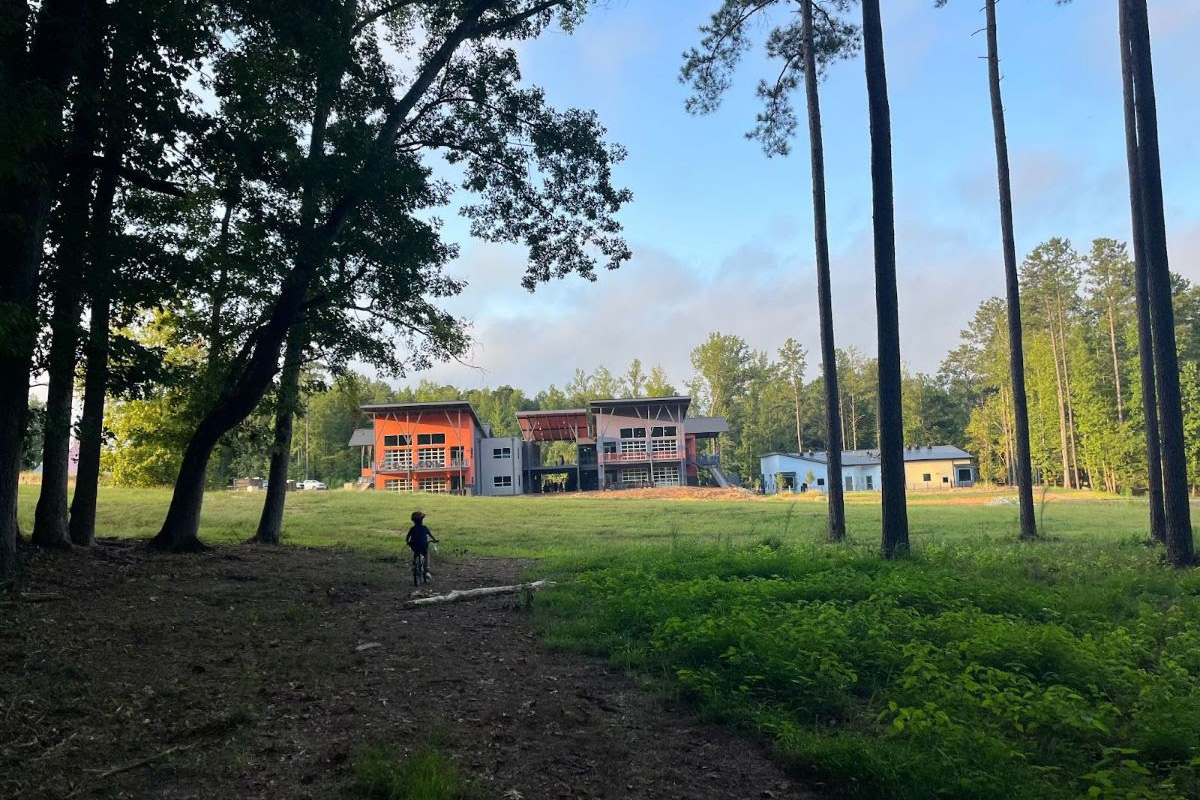
Successful placemaking projects have a good image, provide ample opportunities for activities, are accessible and easy to get to, and encourage sociability. Photo courtesy of Serenbe
Beyond these 11 principles, PPS identifies four core qualities as having a considerable impact on the success of placemaking projects: comfort and image, activities, accessibility, and sociability.
Comfort & Image
As perhaps the most important component in actually attracting people to a place, image—or the way in which a space presents itself—has a huge bearing on the success of any placemaking venture.
Comfort plays a large role in defining a place’s image and speaks to its safety, overall cleanliness, and whether or not it has enough places for people to choose where they want to sit.
Successful placemaking ventures curate an image that is:
- Safe
- Clean
- Green
- Walkable
- Sittable
- Spiritual
- Charming
- Attractive
- Historic
In an age where hostile architecture is on the rise, inviting amenities and comfortable spaces go a long way in creating places where people of all backgrounds feel welcome.
Uses & Activities
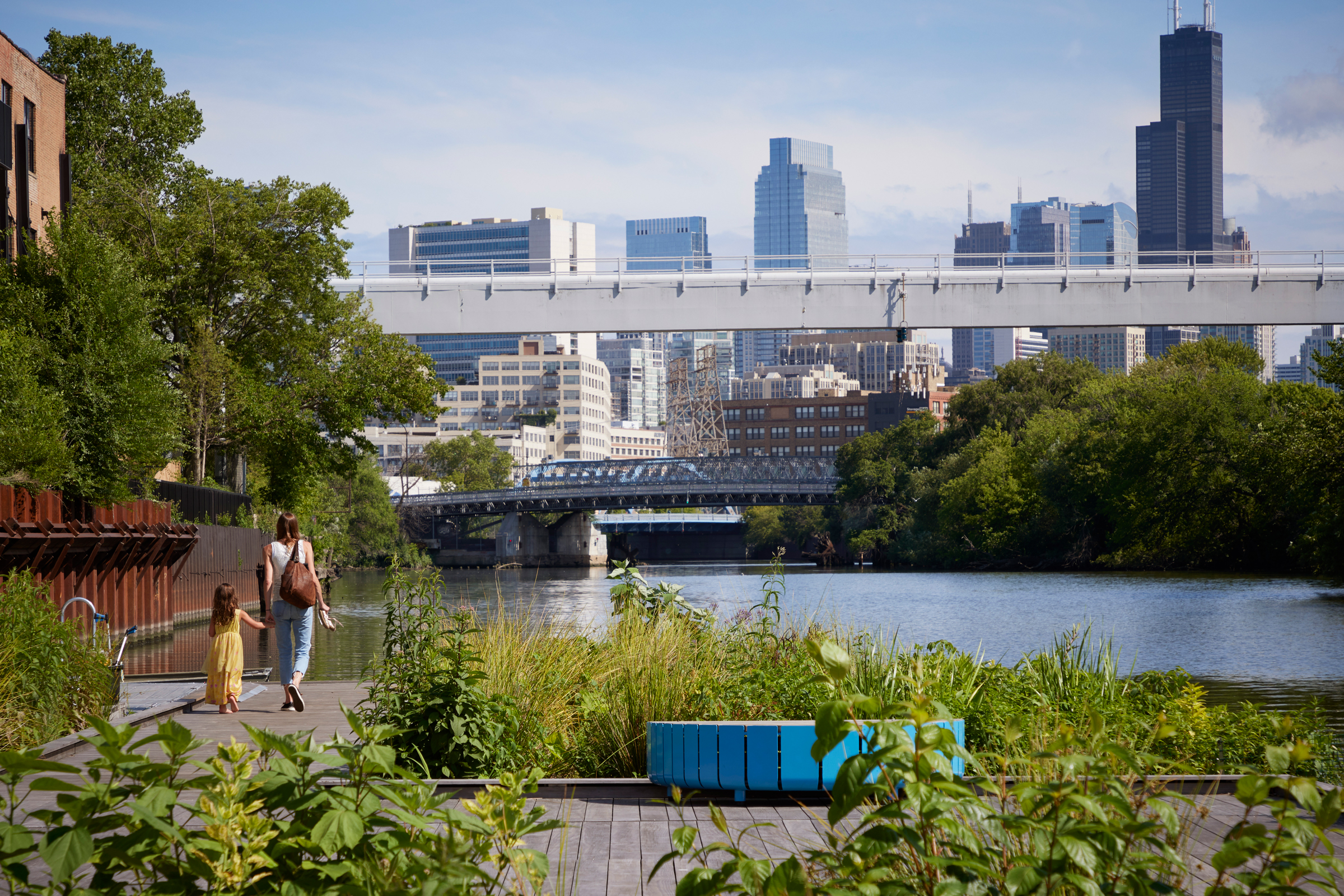
The Wild Mile transforms a formerly industrial riverfront to an inviting habitat for people, plants, and animals. Urban Rivers—one of the organization’s behind the park’s creation—hosts a range of events, volunteer opportunities, and tours year-round as a means of connecting Chicagoans with their local waterways. Photo by Dave Burk
While image and comfort are largely responsible for attracting people to a public space, it is the activities a place offers that actually make people want to visit and keep returning. Spaces in which there is nothing (or at least, very little) to do are more likely to sit empty and unused, whereas successful places have a range of things—both planned and unplanned—for visitors of all ages to participate in.
PPS tells us that these uses and activities should be:
- Fun
- Active
- Vital
- Special
- Real
- Useful
- Indigenous
- Celebratory
- Sustainable
In order for these activities and programs to be successful, there must be ongoing management and planning. This can take the form of dedicated programmers within a facility or organization or partnering with stakeholders and other nearby institutions to bring in events and programs. The former requires the space to act as both organizer and venue, whereas the latter only requires the space to act as the venue.
Accessibility & Linkages
Of course, a positive image and plenty of activities don’t mean much if the place isn’t readily accessible. Quality public spaces should be easy to get to and get through, be in close proximity to a variety of conveniently-located public transportation options, and have a high parking turnover.
A public space may be considered well-linked to its surroundings if it is:
- Connected
- Readable
- Walkable
- Convenient
- Accessible
Successful placemaking projects typically incorporate elements of inclusive design so as to ensure that the widest range of people possible are capable of using the space in an easy, safe, and convenient manner.
Sociability
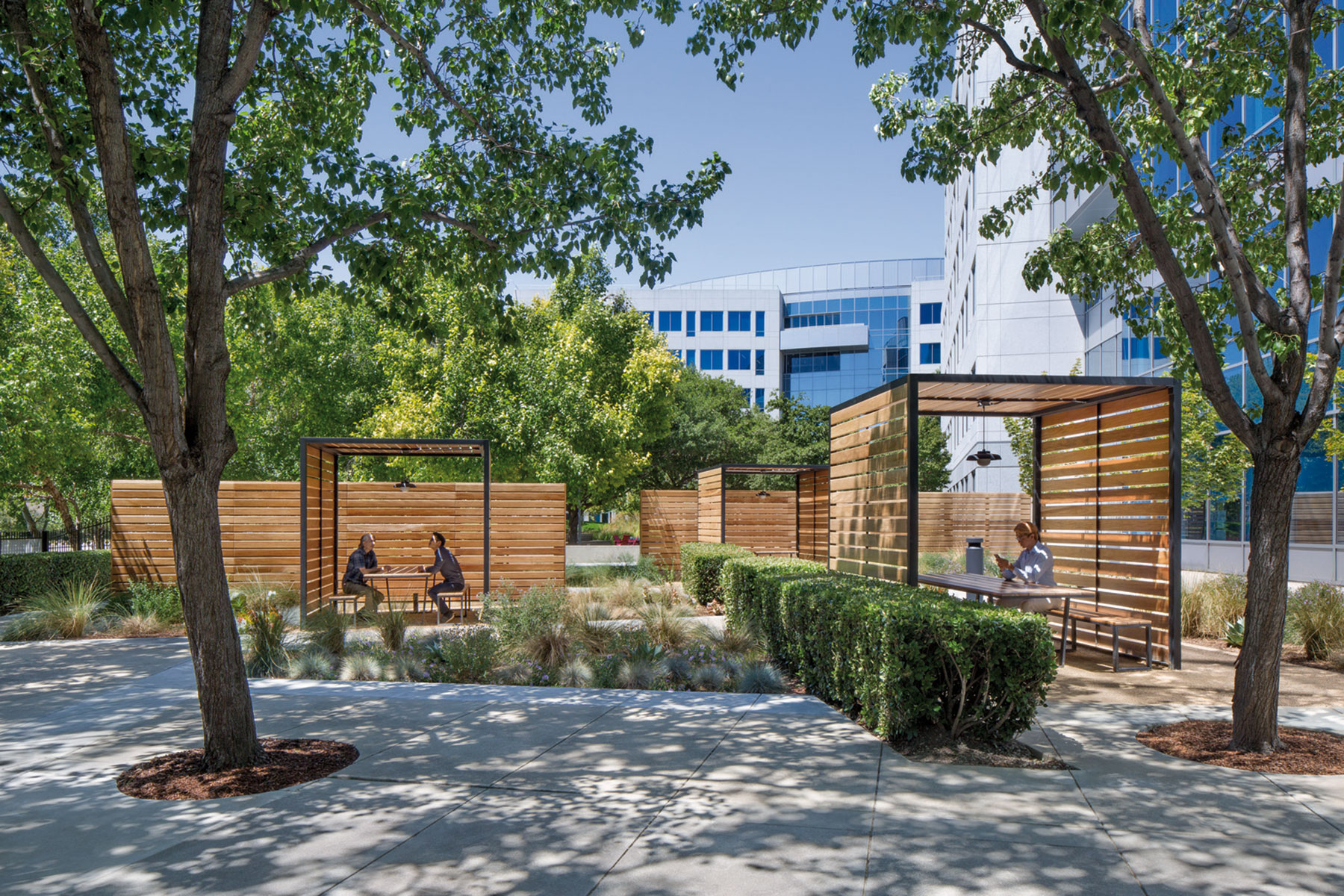
This project for Patelco illustrates how access to outdoor environments in which people can work and socialize has become increasingly important. These informal spaces encourage interaction, help build relationships and provide important access to fresh air and daylight. Photo by David Wakely Photography
Though difficult to achieve and measure, sociability refers to a place’s ability to facilitate and encourage ongoing interaction between friends, neighbors, and strangers. Sociable places are spaces that people frequent by choice, reflect the surrounding community’s entire demographic, and inspire pride and stewardship in occupants.
A place that has effectively used its image, activities, and accessibility to become a social hub is characterized as:
- Diverse
- Cooperative
- Neighborly
- Friendly
- Interactive
- Welcoming
Sociability is the least tangible of all four qualities that go into making a successful public space, but it is often the easiest to feel.
3 Examples of Placemaking in Action
Now that we’ve a better understanding of what placemaking is and how it can be implemented, let’s take a look at a few examples.
1. Serenbe, Chattahoochee Hills, GA
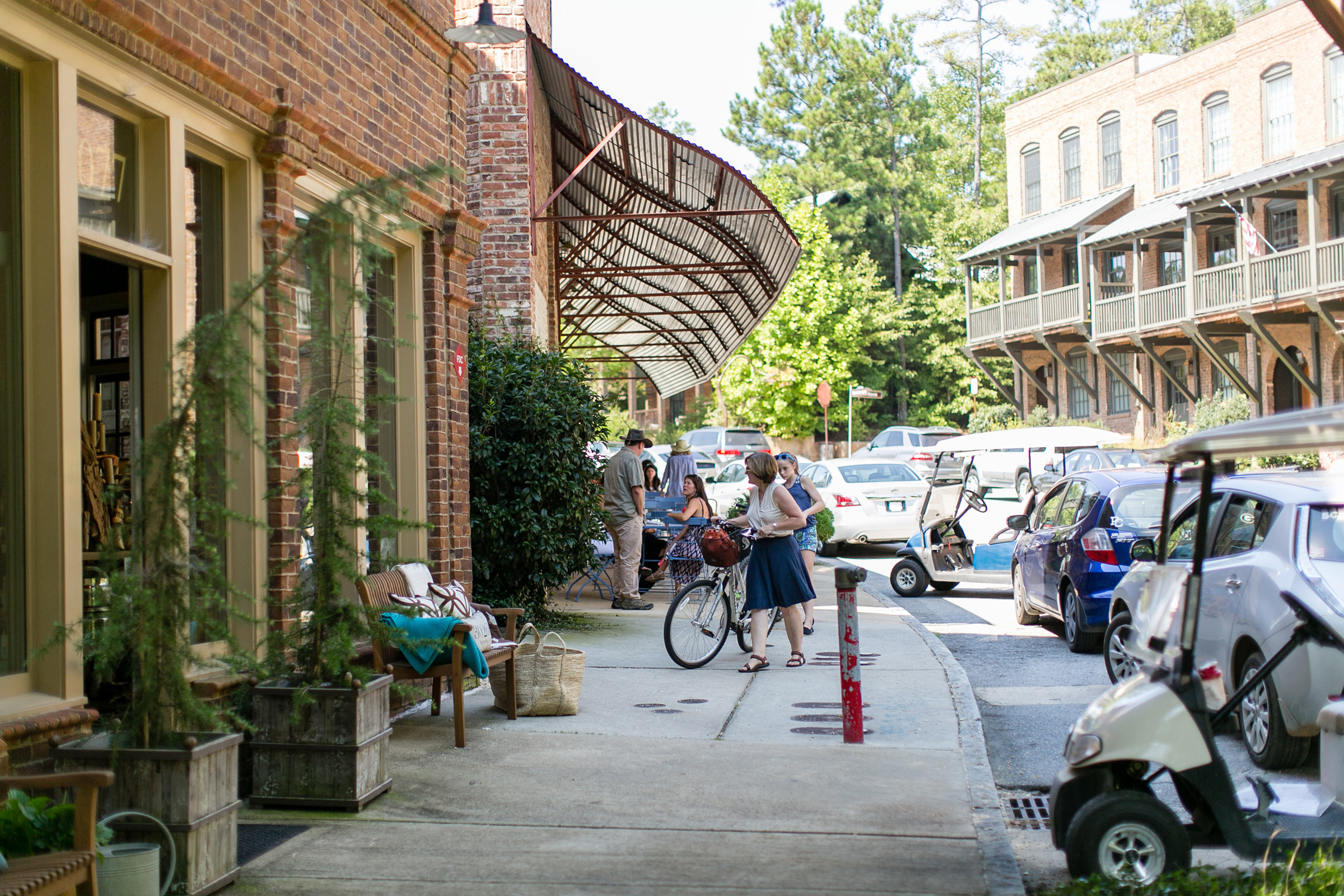
The first house at Serenbe was built in 2004 and today the community is home to over 1,000 residents. Photo courtesy of Serenbe
Modeled after the countryside villages of post-war England, Serenbe is a holistic community whose philosophy is built on the notion that nature, wellness, and biophilia are key to successful placemaking.
The neighborhood is somewhat unique when it comes to placemaking, as most placemaking ventures are looking to improve upon existing public spaces, particularly those in urban or suburban areas. Serenbe, however, began in 2004 on unincorporated, largely undeveloped land on the outskirts of Atlanta.
Over the last 20 years Serenbe has expanded and now encompasses 2,000 acres (though it resides on 40,000 acres) and is mixed-use in every sense of the word, boasting everything from small organic farms and preserved woodland to homes, businesses, and social areas. The neighborhood prioritizes pedestrian infrastructure over vehicle-centric roadways and is incredibly walkable, boasting a highly connected sidewalk network as well as miles of walking trails.
Despite already being home to more than 1,000 residents and multiple businesses, Serenbe is less than 50% built out and far from complete. “We have created a place, and people are coming here,” Steve Nygren, CEO and founder of Serenbe, told gb&d in a previous interview. “That’s what placemaking means. We have people moving to Serenbe who never thought they’d live in the South. That’s because of the place we’ve created.”
2. Winthrop Public Library, Winthrop, WA

The library sits with its long axis pointing to Mt. Gardner with its entrance toward the Methow River. It physically reflects the crossroads of the mountains and river, and also the crossroads of the community, where neighbors can gather, learn, and explore. Photo by Benjamin Drummond
Having long been underserved by a small library with poor access to essential services and multimedia resources, Winthrop—a small town in the heart of Washington’s Methow Valley—needed a library capable of meeting the community’s education, entertainment, and general enrichment needs.
With help from Prentiss Balance Wickline Architects and Friends of the Winthrop Library, Johnston Architects was able to come up with a solution. Hundreds of comments and requests were collected as a part of the firm’s Hopes & Dreams charrette process and used to design a library that fulfilled the community’s goals and addressed those aspects that simply weren’t working.
“We designed the building with an open floor plan to be flexible and continuously adapt its space layout to the evolving needs for programmed activity,” Harmony Cooper, former project architect at Johnston Architects, told gb&d in a previous interview. “Spaces range from intimate reading window seats and quiet study areas to more active teen and children’s areas, flexible meeting halls that can be subdivided, a main stack space where larger events can also happen, and a maker space that is fit for 3D printing and digital fabrication.”
The completed Winthrop Public Library is capable of holding a collection of more than 20,000 materials and houses a large community room available after hours for events, meetings, and other programming.
3. Shoppers World Brampton, Ontario
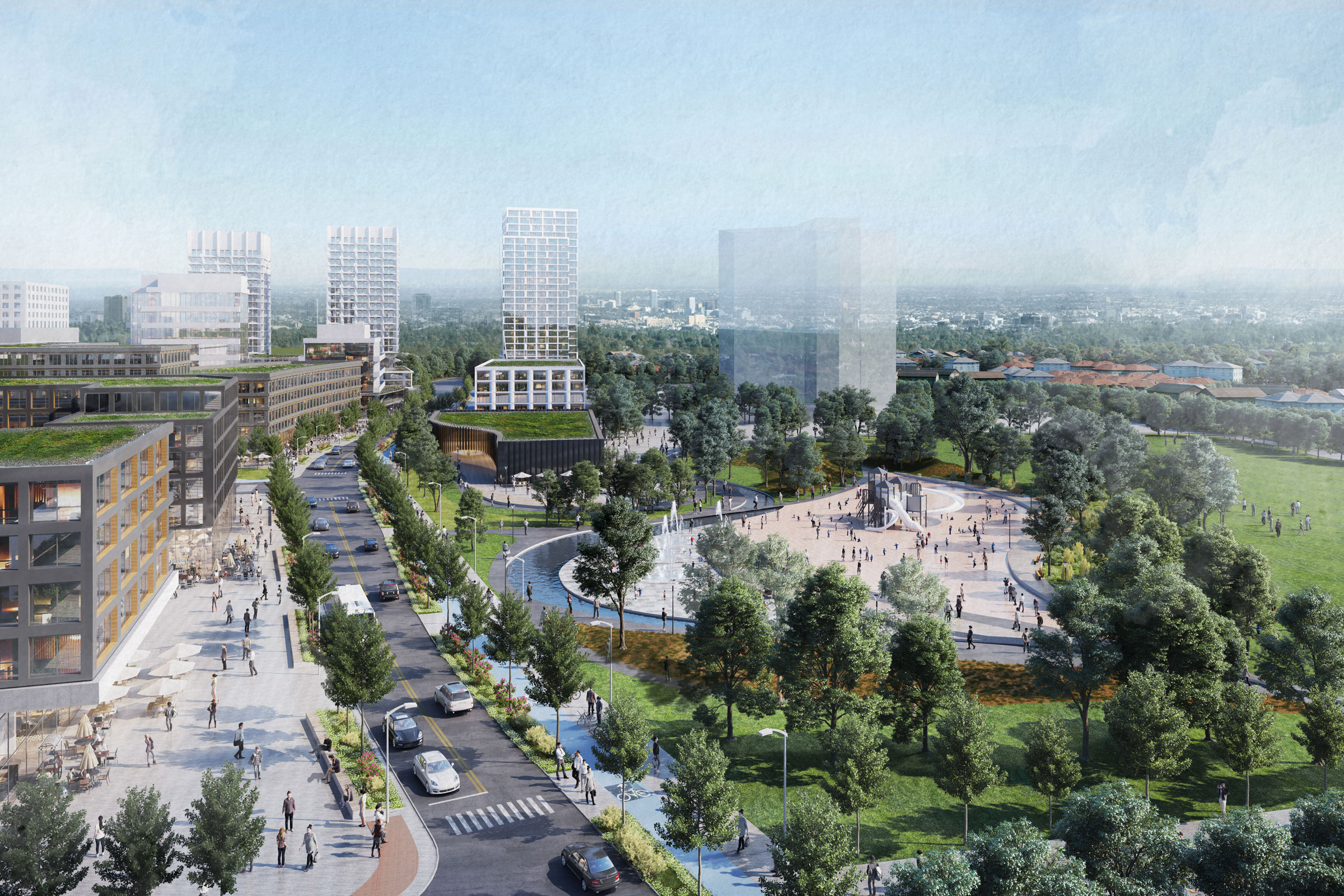
In one of Canada’s fastest growing cities, the master plan vision for Shoppers World Brampton sets new precedents for shopping center revitalizations in Canada. Rendering courtesy of BDP Quadrangle and SvN Architects + Planners
Originally built in the early 1960s, Shoppers World is the main retail destination in Brampton and is located in the city’s “uptown core,” a rapidly growing, demographically young, and ethnically diverse suburban municipality. In 2019 RioCan—the owners of the mall—proposed a massive redevelopment of the site, which would see the mall demolished and a walkable, connected urban mixed-use neighborhood developed in its place.
Expected to take approximately 30 years, the redevelopment of Shoppers World Brampton—headed by SvN Architects and Planners—is guided by a vision rooted in a landscape-first design philosophy, inspired by both the surrounding environment and the site’s past history as a farmer’s field. Many of the project’s new streets and open-space designs are planned in relation to nearby river and creek ecologies, creating a more organic, natural layout.
“The streets that led into Shoppers World and the roadways designed within the site reprioritize the importance of front of house spaces that face onto them, thereby giving prominence to storefronts, entryways, pocket parks, and other landscape architecture features that define our cities—that define successful placemaking,” Shonda Wang, a principal at SvN Architects and Planners, previously wrote for gb&d.
Green roofs, terraces, pocket parks, and courtyards can be found throughout the community and an urban bosque acts as a sound buffer and provides a space for people to gather for markets and pop-up events. “The bosque also serves as a practical wooded framing of a new pedestrian-focused promenade augmented on one side by a continuous linear park,” writes Wang. “Its dual purpose is to re-stitch the Etobicoke Creek on the east and Fletcher’s Creek on the west through an interconnected bio-system.”

